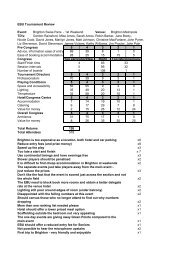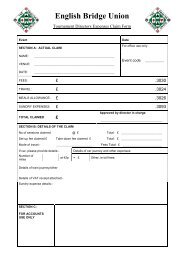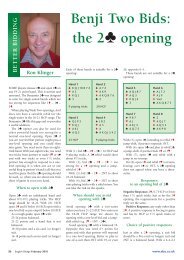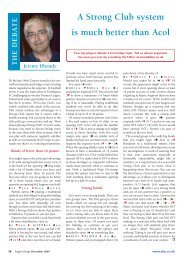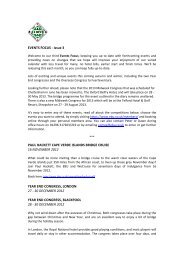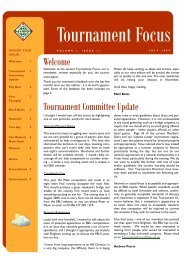Standard English Acol Foundation Level System File
Standard English Acol Foundation Level System File
Standard English Acol Foundation Level System File
You also want an ePaper? Increase the reach of your titles
YUMPU automatically turns print PDFs into web optimized ePapers that Google loves.
2.7 Trial bids<br />
When a suit has been agreed, a trial bid is a bid of a new suit inviting partner to<br />
bid game with a suitable hand. The most common use is when your major suit<br />
has been raised to the twolevel. For example, after the uncontested auction<br />
1♠ 2♠, 3♣ would be a long suit trial bid asking responder to reevaluate his<br />
hand in the light of his club holding. 3♣ shows potential losers in clubs,<br />
typically 3 or 4 cards headed by not more than one high honour. To bid game<br />
responder should have a useful holding in the trial bid suit, either honour cards<br />
or a shortage.<br />
After a minor suit is supported 3NT is often the most likely game. A trial bid<br />
shows a stopper in the suit bid. For example 1♦ 2♦ 2♠ shows spade<br />
values, looking for game.<br />
2.8 Slam bidding<br />
2.8.1 The most straightforward way of bidding a slam is by sheer weight of high<br />
cards. If both hands are balanced you need about 33 HCP to make 6NT, 37<br />
for 7NT. When one player has bid no trumps a bid of 4NT by their partner is<br />
invitational, asking the no trump bidder to bid 6NT with a maximum hand for<br />
their previous bidding. For example:<br />
1♥ 2♣ 3NT shows 1719 HCP, 4NT shows 1415 HCP<br />
3NT 4NT Opener will bid on to slam with a maximum hand<br />
2.8.2 In other circumstances a bid of 4NT is the Blackwood Convention, which asks<br />
partner to show how many aces he holds. The responses are:<br />
5♣ 0 or 4 aces 5♦ 1 ace<br />
5♥ 2 aces 5♠ 3 aces<br />
If the 4NT bidder follows up with 5NT, this confirms that the partnership has all<br />
four aces and asks for kings on the same scale. After 5NT either partner may<br />
bid a grand slam if there appears to be sufficient tricks.<br />
Only use Blackwood when you are certain the response will tell you what you<br />
want to know. In particular, if you have a side suit with two losers and partner’s<br />
response to Blackwood confirms there is one ace missing, you do not know<br />
whether partner can cover your second loser in the side suit. Blackwood<br />
hasn’t given you the answer, so you shouldn’t have used it in the first place.<br />
2.8.3 Another approach is by cue bidding. Once a suit is agreed, a bid in a new suit<br />
which commits the partnership to game shows a control, in other words an<br />
ace, void, king or singleton – a holding that will prevent the opponents from<br />
winning quick tricks in that suit. For example 1♥ 3♥ 4♣ is a cue bid,<br />
showing a control in clubs.<br />
14



